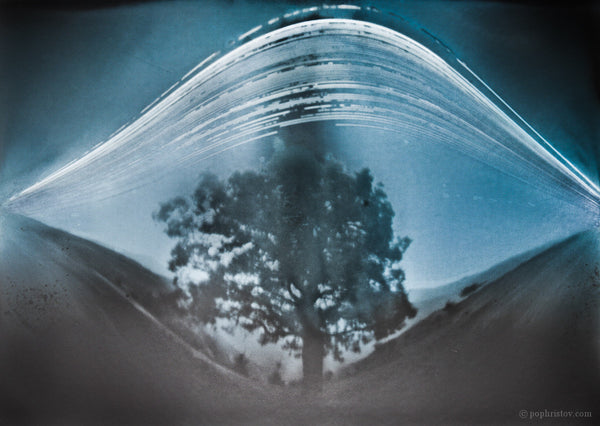
Sun Printing
The sun is key to all our lives and a sunny day makes us all happier (vampires aside) but, did you know that the sun is also great for making a myriad of photographic prints. Over the years many different approaches have been devised to use the suns power to make prints.
Pinhole Photography and Solography
'The Tree of Life - South' - Boris Pophristov Solography - 3-month exposure with a beer can pinhole camera and Ilford paper.

Photo Sensitive Dye
If you always fancied trying screenprinting but found it a bit daunting, Inkodye is the perfect alternative. What's even better is that you get to do it in the sun! Using the power of sunlight Inkodye will transfer your images onto fabric and it couldn't be simpler! Create your own negatives using printable acetate or try shadow printing. This is a great activity to try with kids to help them learn about the photographic process.
Sunprints and Sunography

Anna Atkins cyanotype from her 1843 book, Photographs of British Algae: Cyanotype Impressions
Cyanotype printing is a process using sunlight or UV light to develop the chemically treated paper. Cyanotype was invented in 1842 by Sir John Herschel, but they were first used as a photographic process by Anna Atkins. She used the process to produce Cyanotype books documenting botanical specimens, and because of this, she is regarded as the first female photographer. Similar in its process to Inkodye, there are many ways you can produce your own Cyanotypes at home using a Sunprint Kit or Sunography paper. What image would you capture?
Creating a Photogram is a similar process to Cyanotype but uses standard photographic paper to produce the image of an object. Because you are working with light-sensitive paper you will need to prepare everything in a pitch black room. Any light will expose your paper and render it useless, so find the darkest room in your house and a light-sensitive box to transfer your paper and object outdoors. Get your object stuck in a position in your dark room, place it carefully in your light-sensitive box then take it outside. As soon as you expose it to the sun the paper will react and produce your photogram. Remember to not move your object until you are in a dark room again otherwise your image will disappear. If you want to preserve your image you can either use darkroom fixative or if you want to work chemical free, try scanning your image before it disappears. Take a look at the Photo JoJo blog for some more hints and tips on trying your own photograms.
Have you tried any of these processes? We'd love to see what you have made, share your pictures with us here.


Comments
Leave a comment